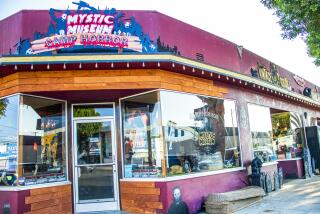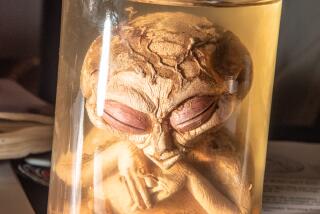You may not believe in Bigfoot or the Loch Ness Monster — but this museum may persuade you otherwise
- Share via
Reporting from PORTLAND, Maine — It all started with a movie supposedly shot in California — and culminated in a museum a continent away.
“Supposedly” because, well, when you’re dealing with mythical — or not — creatures, you just never know for sure. Or do you?
A different film — this one clearly fiction — spurred a vocation for Loren Coleman. When he was a boy in 1960 in Decatur, Ill., he watched a movie titled “Half Human” about an abominable snowman.
The film has affected his life ever since.
At 69, Coleman is one of the world’s leading authorities on cryptozoology, the study of hidden (“crypto”) or rumored-to-exist animals, such as yeti (the Abominable Snowman), Sasquatch and the Loch Ness Monster.
In 2003 he set up what is thought to be the world’s only International Cryptozoology Museum. The 10,000-item nonprofit, which focuses on these legendary creatures, called cryptids, moved in the summer into new digs in a restored industrial landmark in Portland, about 115 miles north of Boston.
Coleman, who has written or contributed to more than 100 books on cryptozoology, natural history mysteries and suicide prevention, has collected a trove of specimens and artifacts, such as “foot casts” and native art.
As I began prowling the two-story museum, I soon came face to face with an 8-foot-tall, supposedly life-size rendering of Bigfoot. Selfie, anyone?
For decades, the hairy, long-armed Bigfoot (a.k.a. Sasquatch) has been a marquee cryptid because, Coleman told me, it’s the “cryptid closest to” humans. It is thought to live in the northwestern United States and Canada.
“California is a rich place for cryptids,” Coleman said. There is, he said, a “historical depth of California sightings.”
He cited examples such as sea serpents, the Abominable Sandman (a desert Bigfoot) and the giant salamander, “A long list of other cryptids have been encountered in the state… They have been seen there,” he said.
Moreover, “the term ‘Bigfoot’ originated in Northern California,” he said.
There has been at least one claim of a Bigfoot sighting in Humboldt County, Calif., about 40 miles south of the Oregon border. It is perhaps the most famous imagery of the creature.
In 1967 Roger Patterson and Bob Gimlin said they encountered an immense ape-like creature walking along Bluff Creek.
Their encounter allegedly produced nearly a minute of footage that included the figure glancing toward the camera before vanishing into the woods.
The footage is part of the museum’s Bigfoot exhibit.
Nearby, another exhibit shows footcasts said to be taken of the tracks of the star of the 1967 movie.
“I am quite convinced they point to the existence of an unrecognized relict hominoid in North America,” scientist Jeff Meldrum said in an email. (A relict hominoid is a surviving species of an otherwise extinct group.)
Meldrum is a professor of anatomy and anthropology at Idaho State University in Pocatello and is an expert in primate locomotion and biomechanics.
Apparently, Bigfoot gets around.
California is a rich place for cryptids
— Loren Coleman
“The numerous footprints photographed and cast throughout the Pacific Northwest and Inter-mountain West indicate the existence of a rare and elusive hominoid referred to as Bigfoot or Sasquatch,” Meldrum said. His scholarly research can be seen in the Relict Hominoid Inquiry.
Meldrum, the editor, described this as an online scholarly journal with the support of an editorial board of fellow academics and professionals with pertinent expertise.
Not everyone is a believer — in Sasquatch or any other cryptid.
There are plenty of mainstream scientists as well as laypeople who claim science fails to prove conclusively the existence of these creatures.
On the other hand, cryptozoologists point to formerly mythical animals that have turned out to exist, such as the giant squid, the okapi (a member of the giraffe family) and the coelacanth, a fish thought to be extinct for 65 million years that’s the museum’s logo.
A whole skin and skull of the okapi was discovered in 1901 in the Democratic Republic of the Congo in Central Africa (formerly Zaire). The animals can now be found in some zoos.
A coelacanth was found to be alive and well in 1938 when one was found in the Indian Ocean near Africa’s southern coast.
Coleman’s approach to the subject? ”I’m an open-minded skeptic and I’m skeptically open-minded,” he said. “We support critical thinking.”
Near the Bigfoot exhibits, there’s a 1989 letter from actor Jimmy Stewart to Coleman about the hand of a yeti that Stewart received in 1959 from a member of a yeti expedition in Nepal.
Stewart packed the hand in his luggage. But on the way home, his luggage was lost. When his bag was later found, “The yeti [hand] was gone.”
In an adjacent display, I found the first item collected by Coleman as a teenager: a flag from Sir Edmund Hillary’s 1960 expedition to search for a yeti in Nepal.
The museum is more than Bigfoot, yeti and other hairy hominoids. Plenty of exhibits deal with other hidden creatures: lake monsters, sea serpents, the Tatzelwurm, a 2- to 6-foot-long lizard-like reptile said to exist in the European Alps.
You can’t talk about cryptozoology without addressing hoaxes, and the museum does. Displays show fakes ranging from the jackalope (jack rabbit with antelope horns, made famous on postcards), a furry trout and a replica of P.T. Barnum’s mummified FeeJee mermaid, the head and torso of an ape sewn to a fish tail.
You may not believe in cryptids, but you can’t deny their effect on popular culture. Curio cabinets abound with Bigfoot dolls, film props and even beverages sporting cryptid names.
How about a “Loch Ness Scotch Whiskey” or a “Sierra Nevada Bigfoot Ale”?
Skeptic or believer? No matter. The museum is fun. And it might make you ponder the idea that hidden beasts could be out there. Plus, you’ll get one heck of a selfie.
If you go
THE BEST WAY TO PORTLAND, MAINE
From LAX, American, Southwest, Jet Blue, Delta and United offer connecting service (change of planes) to Portland. Restricted round-trip fares from $375, including fees and taxes
International Cryptozoology Museum, 4 Thompson’s Point Road. Open 11 a.m.-3:30 p.m. Wednesdays-Mondays; beginning Feb. 10 open Fridays and Saturdays from 11 a.m. to 5:30 p.m. $10 for adults; seniors, $8; $5 for children 12 and younger.
More to Read
Sign up for The Wild
We’ll help you find the best places to hike, bike and run, as well as the perfect silent spots for meditation and yoga.
You may occasionally receive promotional content from the Los Angeles Times.






